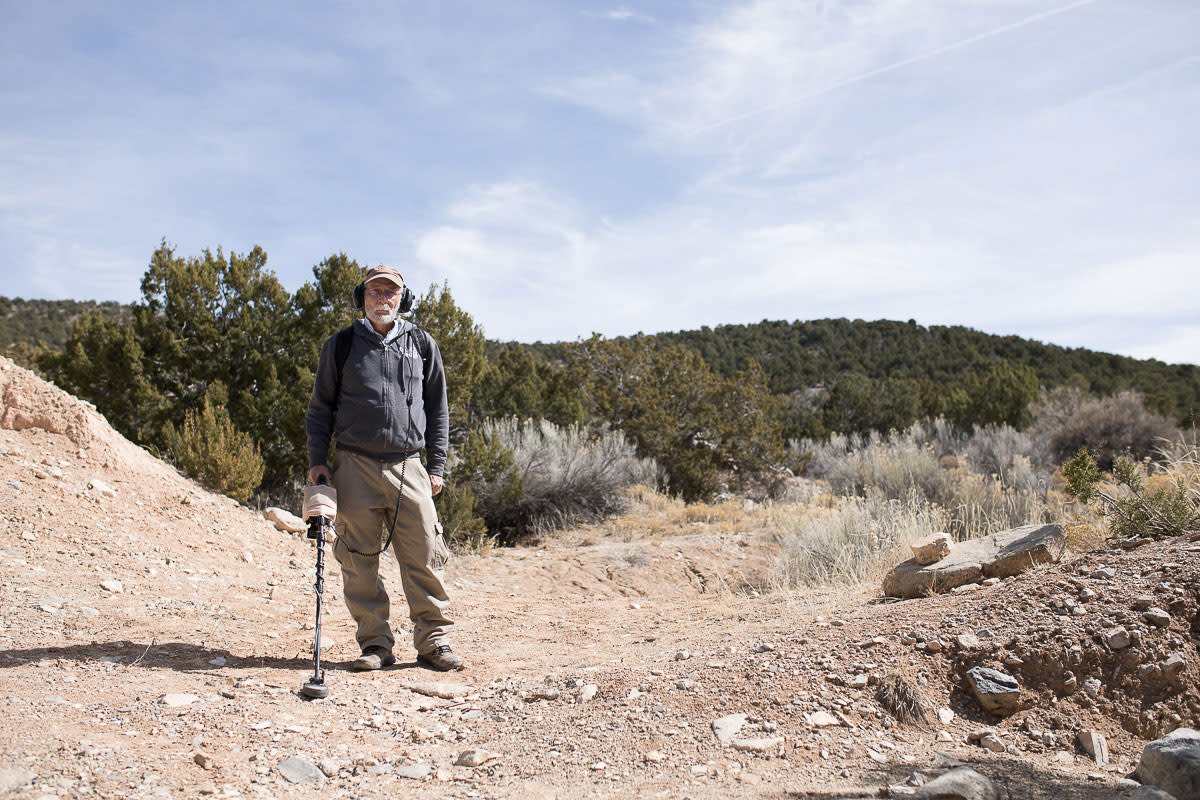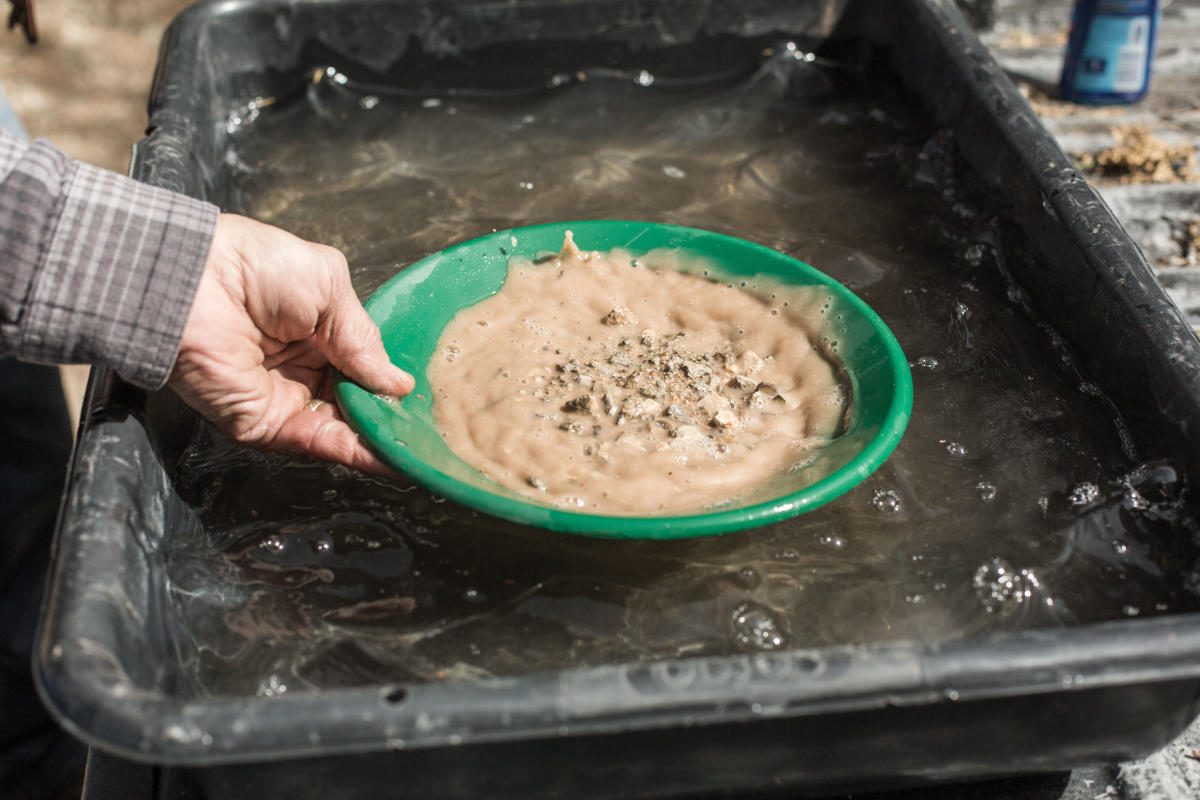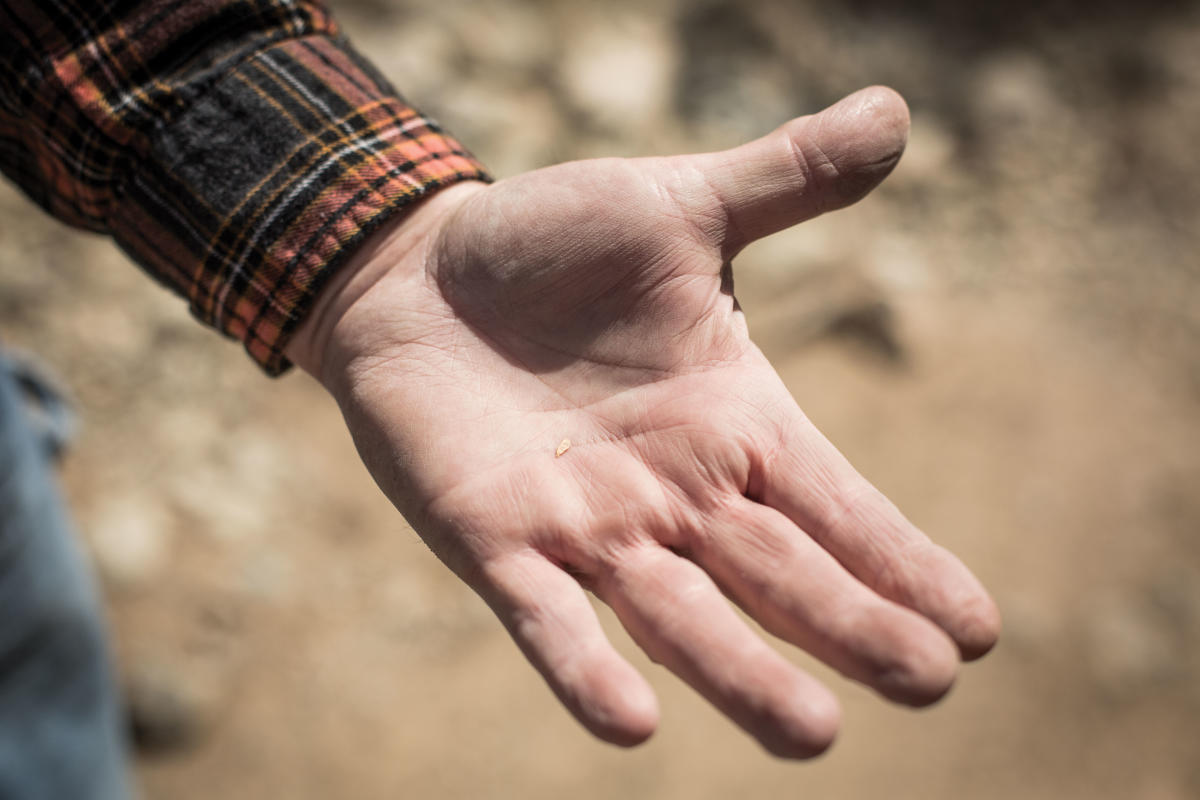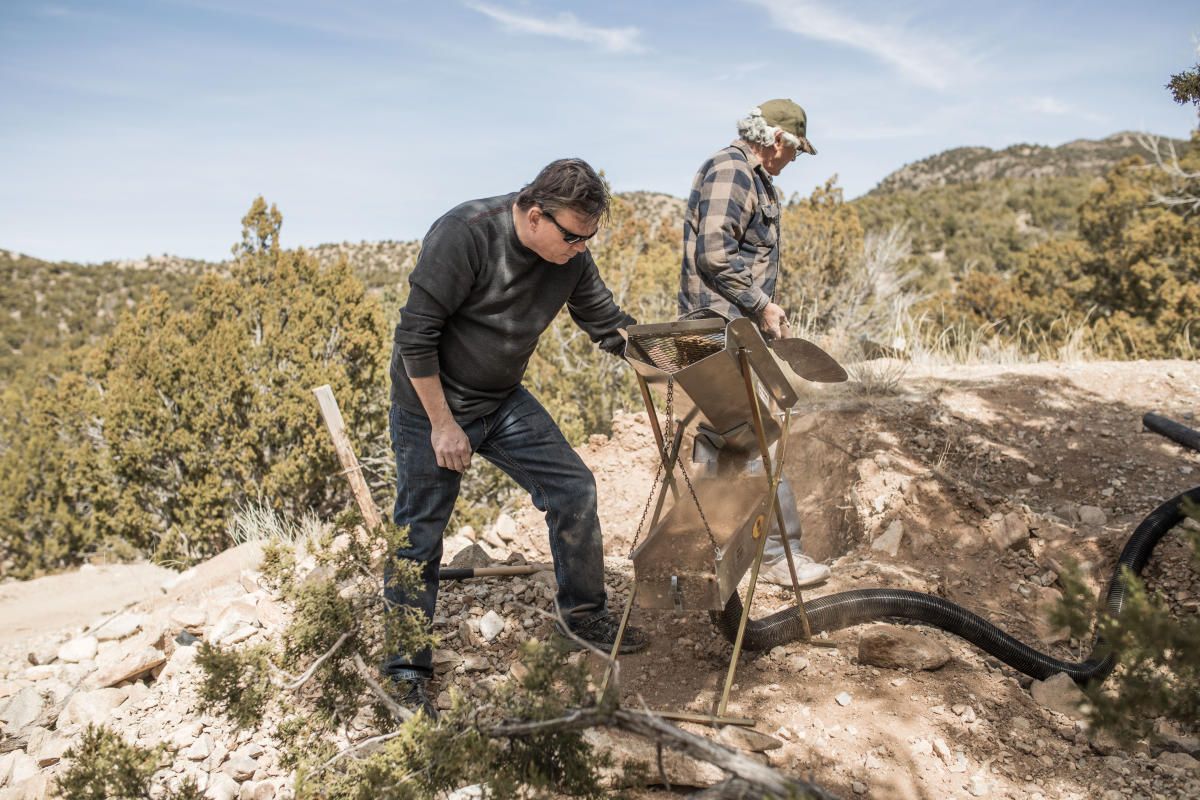Above: Successful prospectors show off their favorite finds. Photographs by Minesh Bacrania.
MARK PATTERSON AND BOBBY GONZALES set up their gold-prospecting equipment in some scroungy piñon-juniper foothills south of Santa Fe.
We agreed ahead of time that, in order to be there, I would not reveal the exact location. To anyone. The mid-February sky is overcast, but not a raindrop falls. For New Mexico prospectors, that’s good, because the equipment works only when the dirt and gravel are perfectly parched.
As I watch them position the contraption on the ground, I can’t help but wonder what Spanish conquistador Francisco Vásquez de Coronado would think if he beheld these spiritual descendants. After all, he sought gold, too, but there the resemblance ends. Back in 1540, Coronado expected to discover entire cities of gold. Seven of them, in fact. These guys’ expectations are considerably more modest. They’ll be happy to find “color”—tiny flecks of gold barely visible in their green prospecting pans or, if fortune smiles, a nugget that could be worth hundreds of dollars. Large or showy specimen nuggets could be worth even more than just their weight in gold.
Coronado planned to heft his sacks of gold onto the backs of mules. Patterson and Gonzales employ dry washers and metal detectors to find their flecks amid tons of gravel, then siphon the gleanings into a little vial.
They are just two of Coronado’s children in modern-day New Mexico. On any free day, they and dozens more New Mexicans scour semi-secret locations throughout the state, along streams, or on mountainsides, fueled by their shared love of the hunt and the certain knowledge that a large piece of gold surely lurks somewhere in the ruck of rubble. As these gold prospectors devote themselves to what some might consider a dubious avocation, they’ve built communities of like-minded hobbyists, gone camping with their families, and found a bit of gold, a lot of junk metal, and a great reason to explore the landscape of New Mexico.
On today’s prospecting expedition, Gonzales and Patterson connect an ordinary leaf blower to their dry washer, an ungainly rig of aluminum and other materials. Gonzales yanks a starter rope to send a burst of air into the washer. Patterson shovels in dry earth. The contraption vibrates, moving the earth down a series of baffles, blowing off dust, and leaving a small pile of dirt below. If a stream were nearby, the prospectors might let water sort the gravel instead—but this is New Mexico.
Eventually Gonzales empties his dry washer of the fine particulates it separated from the gravel. He takes them to his pickup, where he begins processing them the old-fashioned way: with a gold pan using water that he brought with him. With each slosh, the smudge of fine black-iron sand at the pan’s bottom grows smaller. Finally he pronounces, with satisfaction, “Gold!” Someone cries, “I see it!” All of us peer into the pan. Eyes widen, pulses quicken. Gold does that to people. True, the flakes are tiny, and there are only three or four of them. But it’s gold!
 Above: Members of the Gold Prospectors of New Mexico seek a potential payoff, but mostly they enjoy a day outdoors.
Above: Members of the Gold Prospectors of New Mexico seek a potential payoff, but mostly they enjoy a day outdoors.
CORONADO WENT ALL THE WAY to Kansas looking for his golden cities and left New Mexico empty-handed. But people have never stopped hunting for shiny metals here. The first gold rush west of the Mississippi occurred in New Mexico in the 1820s, when gold was discovered in the San Pedro Mountains, east of the village now known, appropriately, as Golden. Soon miners and prospectors swarmed the San Pedro Mountains and neighboring Ortíz Mountains, spawning mining camps so squalid that when U.S. Army lieutenant James W. Abert visited in 1846, he gave thanks that he didn’t own a gold mine.
Gold mining in New Mexico really took off in the late 1800s, with an important strike in the Elizabethtown–Mount Baldy area, near Eagle Nest. Others occurred around Pinos Altos, Silver City, Mogollón, the Jémez Mountains, the Caballo Mountains, and elsewhere. Most deposits were small, however, and soon exhausted. No commercial outfits dig for gold in New Mexico today; oil and gas, copper, and potash dominate the state’s mining industry. Most gold found here comes as a by-product of extracting minerals like silver and copper. But there is perennial talk of resuming gold mining in the San Pedro and Ortíz Mountains.
The area where we found our tiny flakes clearly bears evidence of heavy prospecting. Holes and dirt piles are everywhere. Nearby, two other prospectors are working. They haven’t had much luck, but they don’t seem crushed by disappointment. It’s a nice February day. We’re outdoors. Life is pretty good. Like Gonzales and Patterson, the other two belong to the Gold Prospectors Association of New Mexico, which leases this land from a gravel company. It’s a placer deposit, where gold has been eroded and sorted by wind and water, as opposed to a lode deposit, where the gold is still locked in the rock. (Nowadays, almost all New Mexico prospecting happens in placer deposits.)
Despite New Mexico’s reputation as a treasure state, it never had major strikes, like Central City, in Colorado, or the gold district of California. This is an arid state. Traditional gold prospecting requires abundant water, so, while the entire state has been prospected, some areas only superficially, the haul has been minimal.
But gold is still here. “I believe there’s more undiscovered gold out here than has ever been found,” Gonzales says. “This state is so vast and uncharted. The old prospectors left a lot behind. Now people are using modern technology to find it.”
 Above: Mark Patterson and Bobby Gonzales demonstrate the steps they take to hunt for gold. This is one of the last steps, swirling their found particles in a pan.
Above: Mark Patterson and Bobby Gonzales demonstrate the steps they take to hunt for gold. This is one of the last steps, swirling their found particles in a pan.
Having demonstrated dry washing, Patterson and Gonzales get out their metal detectors, electronic devices that look like grasshopper prosthetics. The two men move the pancake-shaped receivers over the soil and listen. Gonzales hears a squeal and starts digging. Buried about four inches deep is a rusted iron flake about the size of a nickel. Pretty much what he expected to find. It could have been a coin, a piece of jewelry, a square nail, or a boot tack. Most prospectors pocket these false-alarm items, if only so they won’t find them a second time.
I’m dumbfounded that something so small can be detected. These ultra-sensitive devices have transformed modern prospecting, especially in dry areas. I’m quickly addicted to listening for the high squeal that says something is there and then digging to see what it is. Metal detectors that can find gold are not cheap, but every prospector hopes they pay for themselves in gold nuggets—if they can bear to part with their cache. They rarely do. As one prospector told me, “I worked too hard for it.”
THEY'RE A PECULIAR BREED, these gold prospectors. To learn more about them, I go to the January meeting of the Albuquerque chapter of the Gold Prospectors Association of New Mexico, at the Los Griegos Community Center. At any given meeting, 40 to 50 members might be present, though about twice as many have joined. I arrive early, yet most members are already there, clustered at the back of the room, where Gonzales and his wife, Arlene, have set up a display of books and equipment for sale—everything from metal detectors to sluices to snake-protection gaiters. Arlene’s happy to participate. “It’s a family thing,” she says. “The whole family goes camping.”
Most members are men, middle-aged or older. There’s a sprinkling of women, many with their husbands and happily so. I talk to Jackie Weeks. She’s waiting to be joined by her husband, Ken. “We drove from Gallup for the meeting,” she says. “I took up prospecting when he did. It’s fun. It gets you out.”
In one corner, several members discuss the relative merits of various metal detectors. Nearby, people browse books, including ones about where to go prospecting. (Tip: The best place to find gold is where others have found it before.)
Most attention focuses on Jim Bergstrom. On Christmas Day, he went to the association’s claim in those not-to-be-identified foothills. He went by himself, at least in part as a tribute to his recently deceased aunt. She knew of his fascination with gold and each Christmas gave him a piece of it. “With her gone,” he says, “I thought I’d get a piece of gold myself.”

Above: A sample of the gold waiting to be found.
There, as he was looking through rubble discarded by earlier prospectors, Bergstrom’s metal detector squealed and zoomed in on a flat nugget about as large as a quarter—huge by nugget standards. It had been overlooked because it was too large to pass through filters, and the previous miners had wanted only “the fines,” where gold normally occurs. At current prices, the nugget is probably worth about $600—much more if sold as a specimen. But to Bergstrom it holds spiritual value. “I’m keeping it,” he says.
When the meeting begins, I sit with Dean Brubaker, the association’s former president and, at 81, the patriarch of New Mexico’s gold-prospecting hobbyists. He worked at Edwards Air Force Base, in California, for many years but took a transfer to Kirtland Air Force Base, in Albuquerque, just to be in New Mexico. He loves working in the outdoors. Before health problems curtailed her, his wife, Arsenia, had also enjoyed prospecting, especially panning. “When I’d return with a load of gravel,” he says, “she’d sit outside for hours, panning it out.”
Much of Brubaker’s time since retirement has been spent with the prospecting association, and he likes talking about it almost as much as prospecting. “We give demonstrations at fairs, schools, and other organizations,” he says. “We also do community service.” Last year, the association donated 42 Thanksgiving turkeys and 20 Christmas ham dinners to hungry families through the community center. It also distributed 40 kid-size backpacks filled with school supplies.
Acknowledging that gold mining and prospecting have a bad reputation among environmentalists, the association tries to improve its image by stressing that prospectors fill in their holes and clean up their sites. “People still think we’re using mercury and blowing up mountains,” Gonzales says. “When I’m prospecting in a natural area, you’d never know I was there when I leave.”
Gonzales credits his love of prospecting to growing up in Socorro, with its proximity to the prestigious New Mexico Institute of Mining and Technology. Since retiring from the state Department of Transportation and the construction industry, he’s deepened his passion for prospecting. So has his family. Like proud parents everywhere, his wife mentions that their youngest daughter recently won a panning contest.
After the formal meeting, everyone drifts to the back of the room again. They’re friendly and eager to explain to me how they caught the fever. For Dave Loving, all it took was a “picker,” a nugget just big enough to pick up with your fingers. “Thirteen years ago,” Patterson says, “I went out with a co-worker who was a member of the association. I found a little. I was hooked.” Brubaker, a history buff, talks about hearing the echoes of the old miners’ picks when he prospects.
The meeting is fun. I like the prospectors. But then, I’m not there to jump their claims. If I were, they’d change. David Rogers, one of the members, warns me, Yoda-like, “Don’t let this fool you. Solitary and secretive they are.”
 Above: Patterson (left) and Gonzales shovel promising soil into their dry washer.
Above: Patterson (left) and Gonzales shovel promising soil into their dry washer.
ONE PERSON WHO KNOWS prospectors perhaps better than anyone else is Carlos Martinez. As the supervisory lands-and-records specialist for the Bureau of Land Management, he’s responsible for claims filed on federal lands, including those of the National Forest Service. Filing a claim is not as difficult as it might seem, and Martinez helps the hopeful, no matter how unrealistic they are. “I get people asking for a map showing where the gold is,” he says. “If there was such a map, I wouldn’t be sitting here.”
Claims he might issue confer only the rights to the minerals on the land; other people can still hike and hunt there. Patented claims do confer ownership, but a moratorium has been placed on them. And, no, you can’t build a cabin on your claim.
I ask Martinez the question I’ve been wanting to ask everyone: “Do prospectors today ever strike it rich?” He slowly shakes his head. “Today the mega-lode just doesn’t happen. I’ve heard of people finding something, but no one getting rich. But then, being rich can be defined in different ways—being with friends, family, being active in the outdoors.”
Back at the prospecting site in the foothills, as afternoon clouds gather to the west and the air turns chilly, Gonzales and Patterson prepare to leave. They’re happy. They spent time with friends and they found a little gold. The flakes have been stored in a glass vial. Now the metal-detector fragments are put into a souvenir bag, the large equipment stashed in the vehicles, and they’re done.
It’s been a good day, but they know that only a fraction of the gold that’s here has been found, so the prospectors will be back. In the meantime, Gonzales repeats the mantra that inspires all prospectors. “You won’t get rich,” he says, “but you might get lucky.”

GET THE FEVER
These chapters of the Gold Prospectors of New Mexico can hook you up with tools and knowledge.
The Albuquerque group meets at 6:30 p.m. on the third Thursday of the month at Los Griegos Community Center (1231 Candelaria Road NW, Albuquerque, gpanm.com). The Alamogordo group meets at 7 p.m. on the first Tuesday of the month at Desert Lakes Golf Course (2351 Hamilton Road, Alamogordo, nmmag.us/alamogold). The Silver City Forty-Niners group meets at 7 p.m. on the third Thursday of the month at Western New Mexico University’s Student Memorial Center (1000 W. College Ave., Silver City, nmmag.us/scgold). Mama’s Minerals, near Old Town in Albuquerque, sells a full array of mining equipment, including metal detectors, some of which can also be rented (800 20th St. NW, 505-266-8443, mamasminerals.com).


